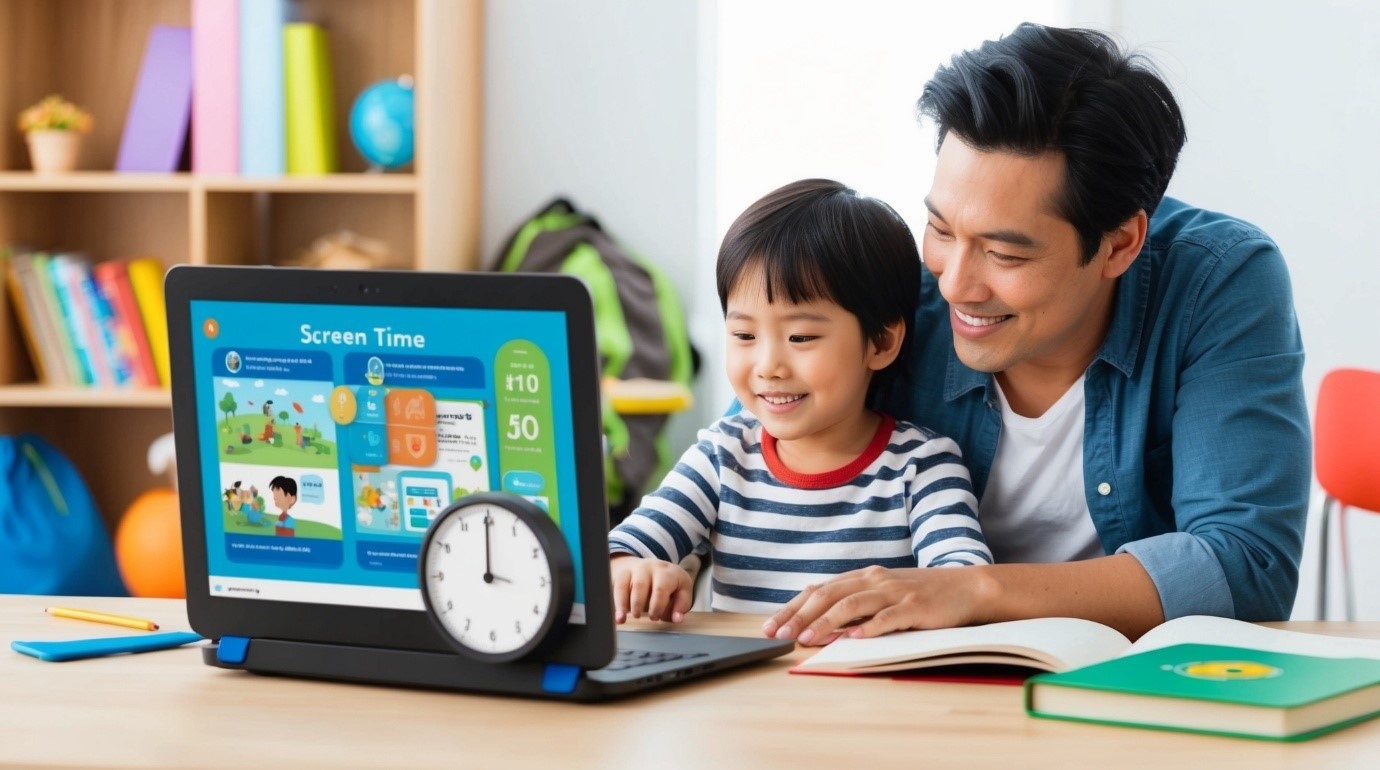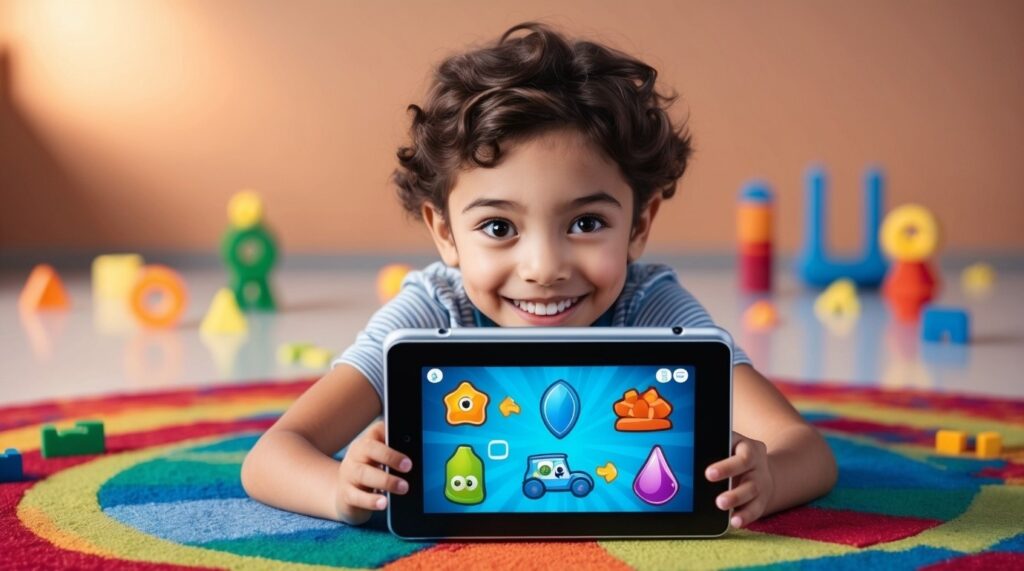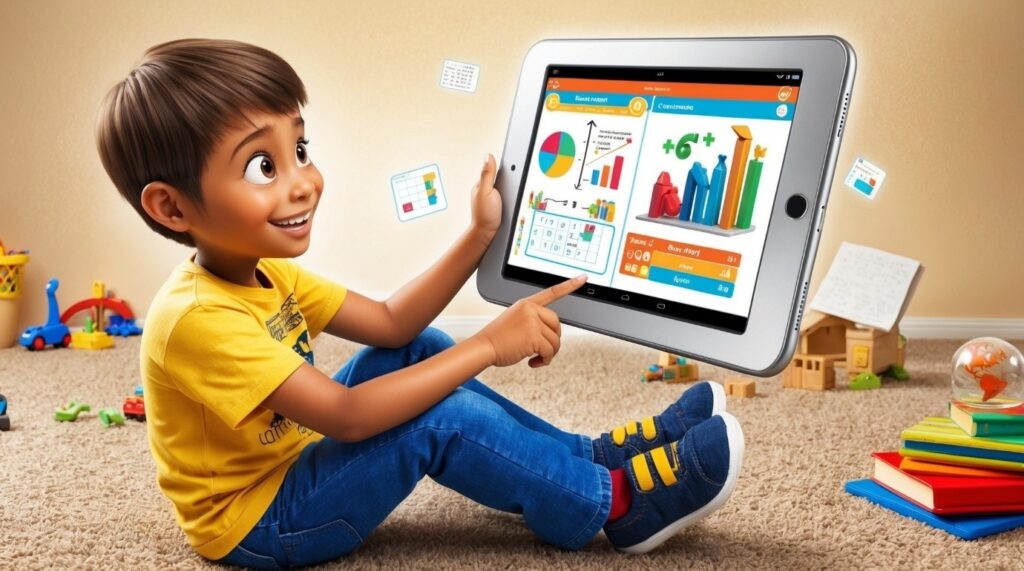A Parent’s Guide to Digital Learning and Screen Time Management
Managing screen time and encouraging digital learning for children can be challenging for parents. With schools incorporating technology into education and kids naturally drawn to screens for entertainment, it’s crucial to strike a balance between productive and educational screen time. However, effective screen time management is essential to ensure a healthy balance. To address this, this guide offers practical tips for managing your child’s screen time while fostering digital learning.

Balancing learning and play—helping kids navigate the digital world with healthy screen time habits.
Striking a Balance: Guiding Kids in the Digital World
As a parent, helping your child establish healthy screen time habits is essential. Understanding how much screen time is suitable for your child’s age and developmental stage can make a big difference. This article provides useful strategies for managing screen time while ensuring that digital learning enhances your child’s education.
Why Digital Learning Matters for Kids
Digital learning opens doors to numerous educational resources, fostering creativity, problem-solving skills, and academic growth. However, moderation and active monitoring are key. Too much screen time can have negative effects, but used effectively, digital tools can support intellectual development.
1. Promotes Critical Thinking and Problem-Solving Skills
Fisrtly, Educational apps and online learning games offer a fun way for children to improve their critical thinking and problem-solving abilities. These activities push kids to engage in tasks that sharpen their intellect and help them think analytically.

Digital learning tools promote critical thinking and creativity while keeping kids entertained.
2. Expands Learning Opportunities
Additionally, Digital learning platforms provide children with the opportunity to explore a wide range of subjects beyond the standard school curriculum. From space and history to the environment, these platforms spark curiosity and encourage kids to learn in an interactive and engaging way. Not only do they expand their knowledge, but they also foster a love for lifelong learning.

Children can explore a wide range of subjects through interactive digital learning platforms.
3. Encourages Creativity and Collaboration
Finally, Many digital learning tools help children express their creativity by enabling them to make videos, art, and projects. Collaborating with peers on assignments also encourages teamwork and communication—skills that are essential for a well-rounded education.
Check other article on: Navigating the Digital Age: A Parent’s Guide to Protecting Kids’ Eyes and Managing Screen Time
Setting Healthy Screen Time Limits for Kids
In today’s world, screens are omnipresent, making it essential for parents to set clear boundaries around screen time. Without limits, excessive screen use can disrupt sleep, decrease physical activity, and even contribute to behavioral issues. On the other hand, the key is to manage screen time effectively while also promoting other activities that support your child’s physical, mental, and emotional well-being.
1. Establish Age-Appropriate Screen Time Guidelines
The American Academy of Paediatrics (AAP) provides clear recommendations for screen time based on age:

Using parental controls, you can easily manage your child’s screen time and create a healthy balance.
2. Screen Time Magngement: Encourage Screen-Free time
Establishing screen-free zones and times throughout the day is an essential part of effective screen time management, promoting face-to-face interaction. Activities such as reading, outdoor play, or family bonding not only provide a break from screens but also help children develop important social and physical skills. Implementing a “no screens” rule during meals and before bedtime can improve sleep quality and foster more meaningful communication.
Tip: Establish a “no-screens” rule during meals and before bedtime to promote face-to-face interactions and ensure a restful night’s sleep.

Screen-free zones, like family meals, promote communication and a healthy family dynamic.
3. Use Screen Time as a Reward System
Use screen time as a motivational tool. Reward your child with extra screen time after completing tasks, like homework or chores. For example, if your child finishes their reading assignment, they could enjoy 20 minutes on an educational app. This approach teaches them to balance leisure with responsibility.
Choosing the Right Educational Apps
With so many options available, it’s important to choose educational apps that are both age-appropriate and engaging. These apps can reinforce your child’s learning and support their academic development.
1. Look for Content That Aligns with Your Child’s Interests and School Subjects
The best educational apps cater to your child’s interests and complement their school lessons. For instance, apps like Toca Lab can spark your child’s interest in science, while Khan Academy Kids reinforces math skills through engaging activities, while Khan Academy Kids is great for reinforcing math skills. These apps provide engaging content that encourages active participation.

Educational apps like Prodigy engage kids with interactive learning, helping them excel in math.
2. Evaluate App Quality and Reviews
Before selecting an app, read reviews and check ratings to ensure it’s suitable for your child. Look for apps that promote creativity and critical thinking, and choose ones that balance entertainment with education.
Tip: Choose apps that offer a blend of entertainment and education, encouraging your child to actively participate in their learning experience.
3. Set Time Limits on Educational Apps
While educational apps are useful, it’s important to avoid letting them become the sole focus of your child’s screen time. Use parental controls to set limits on app usage, ensuring that your child maintains a healthy balance between digital learning and offline activities.
Digital Safety: Protecting Your Child Online
As your child spends more time online, ensuring their digital safety is paramount. Protecting them from inappropriate content, cyberbullying, and other online risks is an important part of managing screen time.
1. Use Parental Controls
Most devices offer parental control features to limit access to harmful content. These controls can help you monitor screen time, block inappropriate apps, and restrict access to age-inappropriate websites.

Parental controls offer peace of mind by managing your child’s access to digital content.
2. Set Up Safe Browsing Habits
Help your child develop safe browsing habits. Encourage them to visit trusted websites and avoid sharing personal information online. Regularly check your child’s browsing history to ensure they’re engaging with safe content.
Tip: Monitor your child’s online activity by regularly checking the browser history or using family-friendly browsers that offer safe, kid-friendly content.
3. Foster Open Communication
Foster a relationship of trust by encouraging your child to talk to you if they encounter anything concerning online. Effective screen time management involves maintaining open communication, which allows you to address issues early and prevent problems from escalating.
Screen Time Management During Homework and Study Sessions
Many children use digital devices for homework, but distractions like social media and games can interrupt their focus. To manage screen time during study sessions, try these strategies:
1. Create a Distraction-Free Study Space
Designate a quiet area for homework where digital distractions are minimized. If your child needs to use a device for research, ensure they only access the necessary apps or websites.
2. Encourage Breaks
Encourage your child to take short breaks during study sessions. Studies suggest that a 5-minute break every 20 minutes can improve focus and productivity.

Regular breaks can help keep children focused and prevent digital fatigue during study time.
3. Use Screen Time for Collaborative Learning
Use tools like Google Classroom or Zoom to facilitate group study sessions. These platforms allow children to work together on assignments while enhancing their digital communication skills. Collaborative learning encourages teamwork while making screen time productive.
Conclusion: Finding Balance in a Digital World
In summary, while digital learning offers a wealth of opportunities for children, achieving the right balance is crucial. By following these steps—setting healthy screen time limits, selecting the right educational apps, and ensuring online safety—you can help your child make the most of their digital experience while fostering a well-rounded lifestyle. The key is to use screen time management to ensure technology enhances their learning while still prioritizing offline activities and interactions.
With a thoughtful approach, you can help your child thrive in the digital world while maintaining a healthy, well-rounded lifestyle.
Ready to Take Control of Screen Time?
Take the first step toward managing your child’s screen time by setting clear boundaries and providing them with valuable educational tools. Explore additional resources and guides to ensure your child’s digital well-being, helping them thrive in today’s tech-driven world.
With the right approach, screen time can become an enriching and educational experience that sets your child up for success in the digital age.
Ready to Manage Screen Time and Foster Digital Learning?
Take the first step toward managing your child’s screen time by setting clear boundaries and providing them with valuable educational tools. Explore additional resources and guides to ensure your child’s digital well-being, helping them thrive in today’s tech-driven world.
Check out these additional articles for more advice:

